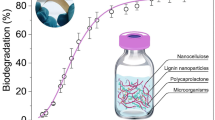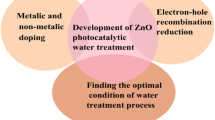Abstract
The emergence of drug-resistant bacteria has induced the development of multifarious methods and materials for sterilization. Nevertheless, the effect of antibacterial materials to environment has still a challenge. To develop a reusable, eco-friendly material for antibacterial and absorption application, a metal porphyrin array modified cellulose terephthalate was fabricated through terephthalate modification of cellulose microfibers (CMFs) extracted from Chlorophytum comosum and interfacial synthesis of sulfide bridged metal porphyrin. The metal porphyrin array (PCN) modified cellulose terephthalate (CMF@PCNCu) exhibited excellent antibacterial capacity to E. coli (Escherichia coli) by interfering with pyruvic acid metabolism at a low-dose of 25 µg·mL− 1 and even at a smaller dose of 10 µg·mL− 1 with synergistic photothermal cure. Interestingly, CMF@PCNCu could absorb 6.8 × 107 CFU of bacteria per milligram, with good bacterial absorption efficiency after three cycles. These findings highlight the promise of CMF@PCNCu as a sustainable bacterial filter and an antibacterial material for the treatment of pathogenic bacteria polluted water.










Similar content being viewed by others
Data availability
All data generated or analyzed during this study are included in this published article (and its supplementary information files).
References
Ahmad H (2021) Celluloses as support materials for antibacterial agents: a review. Cellulose 28:2715–2761. https://doi.org/10.1007/s10570-021-03703-2
Cheng DS, Liu YH, Yan CW, Zhou Y, Deng ZM, Ran JH, Bi SG, Li SY, Cai GM, Wang X (2021) WPU/Cu2-XSe coated cotton fabrics for photothermal conversion and photochromic applications. Cellulose 28(10):6727–6738. https://doi.org/10.1007/s10570-021-03950-3
Cho K, Han SH, Suh MP (2016) Copper-organic framework fabricated with CuS nanoparticles: synthesis, electrical conductivity, and electrocatalytic activities for oxygen reduction reaction. Angew Chem Int Edit 55:1–7. https://doi.org/10.1002/anie.201607271
Dai XM, Zhao Y, Yu YJ, Chen XL, Wei XS, Zhang XG, Li CX (2017) Single continuous near-infrared laser triggered photodynamic and photothermal ablation of antibiotic-resistant bacteria using effective targeted copper sulfide nanoclusters. ACS Appl Mater Inter 9:30470–30479. https://doi.org/10.1021/acsami.7b09638
Gu B, Huang XY, Qiu FX, Yang DX, Zhang T (2020) Laminated cellulose hybrid membranes with triple thermal insulation functions for personal thermal management application. ACS Sustain Chem Eng 8:15936–15945. https://doi.org/10.1021/acssuschemeng.0c05465
Hu YJ, Li N, Yue PP, Chen GG, Hao X, Bian J, Peng F (2022) Highly antibacterial hydrogels prepared from amino cellulose, dialdehyde xylan, and Ag nanoparticles by a green reduction method. Cellulose 29:1055–1067. https://doi.org/10.1007/s10570-021-04359-8
Kumari S, Chauhan GS (2014) New cellulose-lysine Schiff-base-based sensor-adsorbent for mercury ions. ACS Appl Mater Inter 6:5908–5917. https://doi.org/10.1021/am500820n
Lavoine N, Bergström L (2017) Nanocellulose-based foams and aerogels: processing, properties, and applications. J Mater Chem A 5:16105–16117. https://doi.org/10.1039/c7ta02807e
Li ZH, Zhou XC, Shi JY, Zou XB, Huang XW, Tahir HE (2019) Preparation of conducting polyaniline/protoporphyrin composites and their application for sensing VOCs. Food Chem 276:291–297. https://doi.org/10.1016/j.foodchem.2018.10.029
Lu JY, Zhang PL, Chen QY (2020) A nano-BODIPY encapsulated zeolitic imidazolate framework as photoresponsive integrating antibacterial agent. ACS Appl Bio Mater 3:458–465
Luo JW, Deng WJ, Yang F, Wu ZQ, Huang MT, Gu MY (2018) Gold nanoparticles decorated graphene oxide/nanocellulose paper for NIR laser-induced photothermal ablation of pathogenic bacteria. Carbohydr Polym 198:206–214. https://doi.org/10.1016/j.carbpol.2018.06.074
Mu WY, Akrofi R, Chen QY (2020) Near-infrared-driven Au-decorated polymer-metal protein microfibers with bacterial filtration ability for use in photothermal sterilization. Chem Eng J 388:124236. https://doi.org/10.1016/j.cej.2020.124236
Nie CL, Shen T, Hu WC, Ma Q, Zhang JH, Hu SQ, Tian HF, Wu H, Luo XG, Wang JG (2021) Characterization and antibacterial properties of epsilon-poly-L-lysine grafted multi-functional cellulose beads. Carbohydr Polym 262:117902. https://doi.org/10.1016/j.carbpol.2021.117902
Shen HY, Jiang CY, Li W, Wei QF, Reza AG, Wang QQ (2021) Synergistic photodynamic and photothermal antibacterial activity of in situ grown bacterial cellulose/MoS2–chitosan nanocomposite materials with visible light illumination. ACS Appl Mater Inter 13:31193–31205. https://doi.org/10.1021/acsami.1c08178
Shima S, Matsuoka H, Iwamoto T, Sakai H (1984) Antimicrobial action of E-Poly-L-Lysine. J Antibiot 37:1449–1455
Tavakolian M, Jafari SM, van de Ven TGM (2020a) Review on surface-functionalized cellulosic nanostructures as biocompatible antibacterial materials. Nano-Micro Lett 12:73. https://doi.org/10.1007/s40820-020-0408-4
Tavakolian M, Munguia-Lopez JG, Valiei A, Islam MS, Kinsella JM, Tufenkji N, van de Ven TGM (2020b) Highly absorbent antibacterial and biofilm-disrupting hydrogels from cellulose for wound dressing applications. ACS Appl Mater Inter 12:39991–40001. https://doi.org/10.1021/acsami.0c08784
Wei YC, Zhang M, Wu PW, Luo J, Dai L, Li HP, Wang LG, She YB, Zhu WS (2020) Tailoring electronic properties of porphyrin manganese on boron nitride for enhancing aerobic oxidative desulfurization at room temperature. ACS Sustain Chem Eng 8:1015–1022. https://doi.org/10.1021/acssuschemeng.9b05728
Zhang N, Zang GL, Shi C, Yu HQ, Sheng GP (2016) A novel adsorbent TEMPO-mediated oxidized cellulose nanofibrils modified with PEI: Preparation, characterization, and application for Cu(II) removal. J Hazard Mater 316:11–18. https://doi.org/10.1016/j.jhazmat.2016.05.018
Zhang J, Feng YH, Mi JL, Shen YT, Tu ZG, Liu L (2018) Photothermal lysis of pathogenic bacteria by platinum nanodots decorated gold nanorods under near infrared irradiation. J Hazard Mater 342:121–130. https://doi.org/10.1016/j.jhazmat.2017.07.053
Zhou XL, Fu YQ, Chen LD, Wang RB, Wang X, Miao YC, Ji XX, Bian HY, Dai H (2020) Diisocyanate modifiable commercial filter paper with tunable hydrophobicity, enhanced wet tensile strength and antibacterial activity. Carbohydr Polym 248:116791. https://doi.org/10.1016/j.carbpol.2020.116791
Acknowledgments
Financial support of National Natural Science Foundation of China (21571085), Reward Scientific Research Project of Shanxi (SXBYKY2022025).
Funding
This study was supported by grants from National Natural Science Foundation of China (21571085) and Reward Scientific Research Project of Shanxi (SXBYKY2022025).
Author information
Authors and Affiliations
Contributions
W.M: Methodology, investigation, formal analysis, original writing. J.W.: Investigation, experimental operation. Q.C.: Conceptualization, supervision, editing.
Corresponding author
Ethics declarations
Conflict of interest
The authors declare no competing interests.
Consent for publication
All authors agree to public in the journal.
Additional information
Publisher’s Note
Springer Nature remains neutral with regard to jurisdictional claims in published maps and institutional affiliations.
Electronic supplementary material
Below is the link to the electronic supplementary material.
Rights and permissions
Springer Nature or its licensor (e.g. a society or other partner) holds exclusive rights to this article under a publishing agreement with the author(s) or other rightsholder(s); author self-archiving of the accepted manuscript version of this article is solely governed by the terms of such publishing agreement and applicable law.
About this article
Cite this article
Mu, WY., Wang, J. & Chen, QY. Metal porphyrin array modified cellulose terephthalate for sustainable bacterial absorption and sterilization. Cellulose 30, 5845–5856 (2023). https://doi.org/10.1007/s10570-023-05256-y
Received:
Accepted:
Published:
Issue Date:
DOI: https://doi.org/10.1007/s10570-023-05256-y




